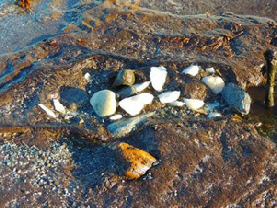
Archaeological treasure risks destruction by the sea 11/11/14
The race is on to save a rare, pre-
Recent storms exposed the remains of the oval-
Archaeologists are excited over the well-
Desperate to save the now fragile basket from the destroying action of incoming waves and harsh winds, specialists are devising a plan to lift it out of the peaty sand.
Gales and rough seas this week risk ripping the basket apart prompting urgent discussions between archaeologists and Historic Scotland over the best way to save the basket.
A council spokesman said an “archaeological find which appears to be a prehistoric basket has been uncovered by the tide in North Uist.”
He pointed out a speedy rescue operation is required.
The spokesman said: “Following its exposure, the deposit is suffering from ongoing erosion with sections being lifted off the underlying sand, therefore the priority is to safely excavate the find so that a complete assessment can be made.”
All going well, the idea is to very carefully cut it out encased in a large block of the surrounding sediment.
Time and tide is working against the operation as the basket is only uncovered by the sea for just a couple of hours in daylight at present.
Weather permitting, an attempt to recover the artefact is expected to be carried out on Thursday afternoon.
Roger Auger spotted the basket while birdwatching along the shoreline.
Mr Auger said: “Normally the area is hidden under the sand. The peat bank was never exposed before.
“I saw a bone sticking up out and then the pile of white quartz crystals. I knew it would be an exciting find as there is an Iron Age wheelhouse nearby.”
Mr Auger reckons the basket could also be “Iron Age or a tad earlier, from the Bronze Age.”
He said one theory is the basket is so well preserved if it was underwater in what could have been a freshwater lagoon, later hidden by silt and beach sediment until now.
The basket is believed to date from the Iron Age or potentially from the earlier Bronze period making it up to 3,000 years old.
Pre-
The ancient relic was exposed by recent storms.
Roger Auger